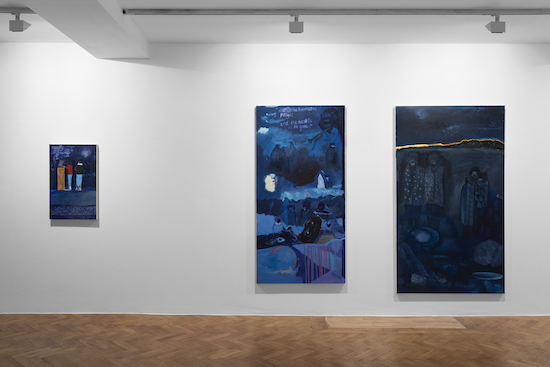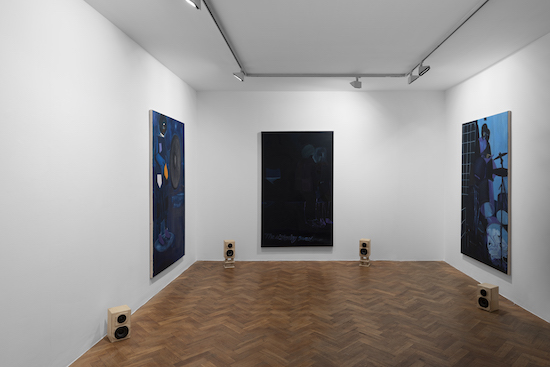Visiting Andrew Pierre Hart’s show at Tiwani Contemporary a few weeks ago, one work in particular stood out for me. It was titled A portrait of the artist composing the show (2021), but the shadowed figure lurking at the back of the frame bathed in blue is not caught posing with a palette or brush. Instead, we find him poised behind a drum kit, as if the exhibition being ‘composed’ were an assemblage less of oil and stretched canvas; more something fabricated purely out of rhythm.
Speaking of the work, Hart cites the American artist Kerry James Marshall’s ideas about, as Hart put it to me, “putting the work of the artist whose making it in the work”. But whereas a work like Marshall’s classic Portrait of the Artist as a Shadow of His Former Self (1980) appears as a haunting grotesque and a striking meditation on social invisibility, Hart’s portrait of the artist, with its unstable grid on one side seemingly melting into hazy forms of the drums and cymbals, speaks more of audibility and the possibility of re-making the world through sound. “My work is about sound,” he tells me – sound at once as an inversion of space and its re-ordering, the rhythmic restructuring of the universe.
It is five years now since Hart took the intensive drumming course that changed his approach to visual art. It was only a month-long course, but its affects were long-lasting. Music has always played a part in Hart’s life, ever since he was at school, playing the euphonium (“the ugliest instrument,” he says now). It didn’t take long for him to get fed up lugging that huge serpentine thing about and switched to piano lessons. Later, he started his own record label. But even running the label, he was “always thinking about art” and the symbiosis between visual and musical languages wherein words like tone, colour, rhythm, gesture, composition shift and slide between the different senses. “How can we talk about one thing through another?” he asks, comparing the “generative” friction that arises between the two to mixing two different records on a turntable. “They create something,” he says, “and you can keep going back to it and the mix is never the same.”
“The first artwork that I worked with was on a kind of turntable,” he says, thinking back to his childhood, painting at the local youth club,“because it was on a ceramic wheel.” Over the last five years, the bleed of sound into painting and vice versa has only become more concrete. After his drum lessons in 2016, Hart started to “paint the painting as a drum”. We’re chatting via Zoom and he’s in his studio in another part of London. By way of explanation, he points his phone’s webcam at a freshly-stretched blank canvas, suspended horizontally by his side. “I think of it [the canvas] as a drum skin,” he says, as he taps and strokes at the surface with his hands. “The music’s playing and the marks are being made as I’m going.” It’s an elegant metaphor: the canvas as drum. Both objects being essentially no more than a skin stretched taut over a rigid frame. “Where it came from,” he explains, “I made one of these and I made it really tight then as I moved it, it went –” he slaps the surface of the canvas with his palm. The sound doesn’t really translate down the tinny microphone of his phone (or the even tinnier speakers on my laptop), but Hart assures me that “makes a really nice bass note. It started from there. Then I did a performance piece where I turned it around and played beats on the stretcher bars.”

An exhibition of work by Hart is always a multi-sensory affair, and sound plays an important part in that. He tells me about his disappointment with the Tate’s landmark Soul of a Nation: Art in the Age of Black Power show from 2017. “The music was the last part,” he says, “as we went out, which I felt was an afterthought, whereas I thought that the music could have been inside the space where it would have really activated something more.” For Hart’s own shows, the activation of the work by some sort of soundtrack has always been integral. At Tiwani, there was a set of loudspeakers on the floor broadcasting a playlist put together by the artist, focused around Miles Davis’s epic ‘Guinnevere’, a track from the Bitches Brew sessions that finally saw the light in an expanded edition of that album released in 1998.
“That song in particular,” he tells me, “for a good three or four months, I’d listen to it every day. The show was built around that song. All of the paintings sit within the field of that song somehow.” In the studio, he’ll almost always be listening to music as he paints and he feels that the mood of the song seeps into the works somehow, as if recorded in every brush gesture. “I’ve done these experiments before where I’ve played particularly types of music with the paintings in the space and you can tell whether or not it goes, whether the paintings like the music. Sometimes it happens kind of without us knowing. It’s there but it’s not there. It’s not something that we clearly notice, but it adds to our experience.”
Such a use of sound, he admits, has from time to time proved a “challenge” to galleries and curators. Putting together the final show for his MA in Painting at the Royal College of Art in 2019, “because the space was quite open, some students were worried that [the soundtrack] was affecting their own work. But actually there was a moment where we realised that it really activated the space – not just my work but the work around it as well.”
"The experience of painting can be activated further," Hart insists. "I think that the digital onslaught has desensitised us. For us to get that deeper emotional connection, we need to activate more of the senses."


